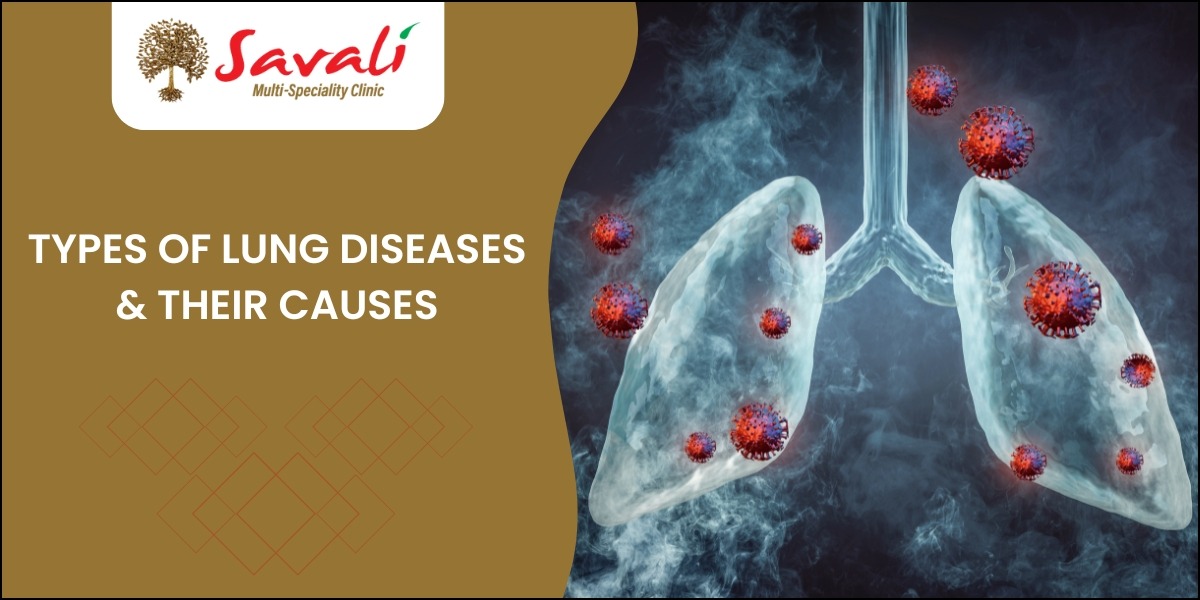The lungs play a vital role in supplying oxygen to the body and removing carbon dioxide. However, various lung diseases can impair this function, leading to breathing difficulties and other health complications. Understanding the different types of lung diseases and their causes can help in early detection and effective treatment.
1. Asthma
What is it?
Asthma is a chronic inflammatory disease that causes the airways to narrow, swell, and produce extra mucus, leading to wheezing, coughing, and shortness of breath.
Causes:
- Genetic predisposition
- Allergens (dust mites, pollen, pet dander)
- Air pollution and smoke
- Respiratory infections
- Physical exertion (exercise-induced asthma)
2. Chronic Obstructive Pulmonary Disease (COPD)
What is it?
COPD is a progressive lung disease that obstructs airflow, making breathing difficult. It includes chronic bronchitis (long-term cough with mucus) and emphysema (damage to lung air sacs).
Causes:
- Long-term smoking (primary cause)
- Exposure to air pollutants (chemical fumes, dust)
- Genetic factors (Alpha-1 antitrypsin deficiency)
- Frequent lung infections
3. Pneumonia
What is it?
Pneumonia is an infection that inflames the air sacs in one or both lungs, filling them with fluid or pus.
Causes:
- Bacterial, viral, or fungal infections
- Weakened immune system
- Smoking and alcohol abuse
- Chronic illnesses (diabetes, heart disease)
4. Pulmonary Fibrosis
What is it?
This condition involves scarring of lung tissue, making it thick and stiff, which reduces oxygen flow to the bloodstream.
Causes:
- Long-term exposure to toxins (asbestos, silica dust)
- Autoimmune diseases (rheumatoid arthritis, lupus)
- Radiation therapy
- Certain medications
5. Lung Cancer
What is it?
Lung cancer occurs when abnormal cells grow uncontrollably in the lungs, forming tumors that interfere with lung function.
Causes:
- Smoking (major risk factor)
- Secondhand smoke exposure
- Radon gas and asbestos exposure
- Family history of lung cancer
6. Tuberculosis (TB)
What is it?
TB is a bacterial infection caused by Mycobacterium tuberculosis, primarily affecting the lungs but can spread to other organs.
Causes:
- Close contact with an infected person
- Weakened immune system (HIV/AIDS, malnutrition)
- Living in crowded or unsanitary conditions
7. Pulmonary Embolism
What is it?
A pulmonary embolism is a blood clot that travels to the lungs, blocking blood flow and causing sudden breathlessness.
Causes:
- Deep vein thrombosis (DVT)
- Prolonged immobility (long flights, bed rest)
- Obesity and smoking
- Certain medical conditions (heart disease, cancer)
8. Bronchiectasis
What is it?
This condition involves permanent widening of the bronchial tubes due to chronic inflammation, leading to mucus buildup and infections.
Causes:
- Severe respiratory infections (whooping cough, pneumonia)
- Cystic fibrosis
- Autoimmune disorders
9. Pleural Effusion
What is it?
Pleural effusion is the buildup of excess fluid between the layers of the pleura (lining around the lungs), causing compression and breathing difficulties.
Causes:
- Congestive heart failure
- Infections (pneumonia, TB)
- Lung cancer
- Liver or kidney disease
10. Cystic Fibrosis
What is it?
A genetic disorder causing thick, sticky mucus buildup in the lungs, leading to severe respiratory and digestive problems.
Causes:
-
Inherited defective gene (CFTR mutation)
When to See a Pulmonologist?
If you experience persistent symptoms like:
– Chronic cough
– Shortness of breath
– Wheezing or chest tightness
– Coughing up blood
– Frequent lung infections
It’s crucial to seek medical attention. Early diagnosis and treatment can prevent complications.
For respiratory care, consult Dr. Laxmikant Kawtekwar, a leading pulmonologist in Hadapsar, Pune, at Savali Multispeciality Clinic. With advanced diagnostic tools and personalized treatment plans, Dr. Kawtekwar ensures effective management of lung diseases.
Lung diseases can significantly impact quality of life, but awareness of their causes and symptoms can lead to timely intervention. Whether it’s asthma, COPD, or lung infections, proper medical care is essential.

